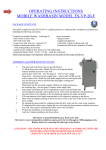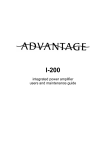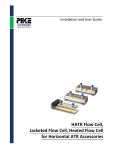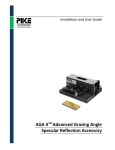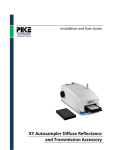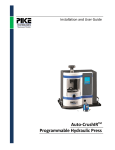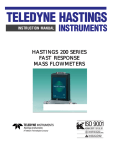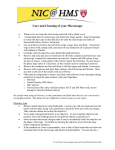Download JetStream ATR Accessory
Transcript
Installation and User Guide JetStream ATR Accessory The information in this publication is provided for reference only. All information contained in this publication is believed to be correct and complete. PIKE Technologies, Inc. shall not be liable for errors contained herein nor for incidental or consequential damages in connection with the furnishing, performance, or use of this material. All product specifications, as well as the information contained in this publication, are subject to change without notice. This publication may contain or reference information and products protected by copyrights or patents and does not convey any license under the patent rights of PIKE Technologies, Inc. nor the rights of others. PIKE Technologies, Inc. does not assume any liability arising out of any infringements of patents or other rights of third parties. This document contains confidential or proprietary information of PIKE Technologies, Inc. Neither this document nor the information herein is to be reproduced, distributed, used or disclosed, either in whole or in part, except as specifically authorized by PIKE Technologies, Inc. PIKE Technologies, Inc. makes no warranty of any kind with regard to this material including, but not limited to, the implied warranties of merchantability and fitness for a particular purpose. Copyright 1991-2013 by PIKE Technologies, Inc., Madison, WI 53719. Printed in the United States of America. All world rights reserved. No part of this publication may be stored in a retrieval system, transmitted, or reproduced in any way, including but not limited to, photocopy, photograph, magnetic or other record, without the prior written permission of PIKE Technologies, Inc. Address Comments to: PIKE Technologies, Inc. 6125 Cottonwood Drive Madison, WI 53719 Phone Fax E-mail Web Site Jan. 1, 2013 (608) 274-2721 (608) 274-0103 [email protected] www.piketech.com Contents Introduction Unpacking Your Accessory Packing List Installation Performance Verification Sampling Procedures Cell Filling Cell Cleaning Disassembly Re-Assembly ATR Spectra ATR Correction Theory How ATR Works Depth of Penetration Precautions SAFETY Mirrors Crystal Care 1 2 2 3 3 4 4 4 5 7 10 11 12 12 12 13 13 13 13 Introduction The PIKE Technologies JetStream ATR Accessory is designed for use in your FTIR spectrometer. The compact design employs a pair of transfer optics to direct the infrared beam to one end of an IR transmitting ATR crystal. A similar pair of optics directs the beam emitted from the other end of the ATR crystal to the spectrometer detector. The ATR crystal for the JetStream ATR Accessory is of a cylindrical shape and is 82 mm long and 6.4 mm thick. The volume of the sample chamber is 1.2 ml. In order to produce optimum performance from the accessory, the length and diameter of the crystal has been carefully chosen. A larger diameter crystal would result in less bounces of the infrared energy in the crystal, resulting in lower absorbances in the resulting spectrum. A smaller diameter crystal would give more bounces in the crystal, resulting in a greater absorbance in the spectrum, but the overall throughput of the device would be reduced. This design gives 12 bounces of light along the cell surface. The standard crystal dimensions have been chosen to maximize the signal to noise in the resulting spectra. The maximum pressure rating is 1500 psi. Figure 1. Schematic of the JetStream ATR Accessory and optics PN 350-0201900-00 P a g e |1 Unpacking Your Accessory In order for you to quickly verify receipt of your accessory, we have included a packing list. Please inspect the package carefully. Contact PIKE Technologies if any discrepancies are noticed. Packing List User Manual JetStream ATR Accessory Hex Wrenches PN 350-0201900 PN 020-19XX Quantity 1 Set Quantity 1 Quantity 1 (Crystal ordered separately) PN 350-0201900-00 P a g e |2 Installation The JetStream ATR Accessory has been aligned and tested to ensure that it performs to specification. There are no customer alignments necessary. 1. Set your FTIR spectrometer to collect data at 4 cm-1 resolution (including FTIR J-stop). Your JetStream ATR Accessory is set to an appropriate configuration to fit the sample compartment of the FTIR instrument you specified. Before inserting the accessory in the sample compartment, ensure that your spectrometer is aligned. If the instrument is not aligned, follow the manufacturer’s instructions for maximizing the interferogram signal (the IR energy throughput) of your FTIR spectrometer. 2. Fasten the accessory onto the FTIR sample compartment by attaching the supplied baseplate to the bottom of your spectrometer. The JetStream ATR Accessory is now ready for use. Performance Verification 1. With the accessory removed from the sample compartment, collect a background spectrum. 2. Place the JetStream ATR Accessory in the instrument. 3. Collect a transmission spectrum using the same collection parameters as used to collect the background spectrum. The transmission value of this accessory should be at least 7% for ZnSe and 6% for Ge at 1000 cm-1. If your accessory does not meet this minimum transmission value when installed, please contact PIKE Technologies. A typical energy throughput spectrum is shown in Figure 2. 20 18 16 14 %T 12 10 8 6 4 2 0 5000 4500 4000 3500 3000 2500 2000 1500 1000 cm-1 Figure 2. Sample throughput spectrum of the JetStream ATR Accessory with ZnSe crystal PN 350-0201900-00 P a g e |3 Sampling Procedures The sample spectrum is obtained by ratioing a sample scan collected with a sample in the JetStream ATR Accessory to a background scan collected with no sample on the face of the crystal or to a background scan collected with the pure solvent or other reference material in the cell. Cell Filling The cell may be removed from the accessory base for convenient filling and emptying. The cell has been supplied with compression gas fittings for gas or liquid flow samples. Always check the sealing prior to use by filling the cell while the cell is removed from the spectrometer. The surface of the crystal should be fully covered for proper measurements, thus make sure that the liquid flows out clearly without any bubbles indicating that the cell is full. After the sample has been measured, the cell needs to be flushed with the next sample until there is no residue left from the previous sample. Should the next sample be different in its chemical nature or the concentration is very different, the cell needs to be washed in between samples. Cleaning and cleaning validation is application and sample specific so the user must make sure that there is no cross contamination from an earlier sample that could change the measurement results. Cell Cleaning Sometimes “carry over” may occur from one sample to another due to incomplete cleaning of a prior sample from the face of the crystal. This effect may be minimized by “washing” the sample chamber with the new sample, cleaning the crystal and then running a background scan. The sample is then injected again and a sample spectrum collected. The cell can be cleaned easily by flushing the cell with an appropriate solvent, detergent or other cleaning fluids. Be sure to use solvents that are chemically compatible with EPDMTM cell seal. Contact PIKE Technologies for KalrezTM O-ring options. Samples should never be left in contact with the crystal for an extended period of time as some samples may degrade the crystal material. Once the measurement has been made, remove the sample from the crystal by cleaning the cell with a suitable solvent. Should the crystal surface inside the cell get contaminated such that it is not removable by flushing the cell, the only remedy is to take the cell apart. This has to be performed with care, because the crystal is fragile. Scratches on the surface of the crystal will result in reduced energy throughput of the accessory. PN 350-0201900-00 P a g e |4 Disassembly 1. Remove the cell from the accessory by unscrewing the two hex head socket cap screws at the top of the cell, then lifting the cell out of the accessory. 2. Set the cell on a flat surface. Loosen button screws on the sides of the cell ½ turn. 3. Once all screws are loose, remove all screws and the outer caps on both ends. PN 350-0201900-00 P a g e |5 4. Gently push crystal face on one side into the cell, to free the O-ring seal on the opposite side. Carefully pull the crystal out of the flow cell. The crystal surface is now exposed and can be cleaned. Note that the crystal used in the accessory is made from zinc selenide, a fairly brittle material. A solvent (see the section below on crystal cleaning) and a “Q tip” should be used to remove traces of a previous sample. Apply the solvent to the crystal with a Q-tip and gently remove using a Q-tip or non-abrasive wipe. Repeat this procedure until all traces of the sample have been removed. The solvent used for cleaning your crystal is dependent on the sample that has been analyzed. In all cases it is best to attempt to clean the crystal with the mildest solvent possible. For most cases the preferred solvent is isopropyl alcohol. If a more vigorous solvent is required, acetone may be used. In very stubborn cases dimethylformamide may be used. In all cases when using solvents, inspect the materials safety data sheet associated with the solvent you are using and comply with any recommended handling procedures. Also, confirm solvent compatibility with the liquid cell O-ring. NOTE: Under no circumstances must the crystals be rubbed with paper products such as “Kleenex”. Many paper products are abrasive and could cause scratching of the crystal surface. PN 350-0201900-00 P a g e |6 Re-Assembly Once the ATR crystal and the cell interior are clean and dry, the cell can be re-assembled. 1. Place large O-rings onto inner caps. Slide inner caps into place on either end of the cell. Make sure the screw holes are properly aligned. 2. Slide one of the small O-rings onto the end of the ATR crystal. 3. Carefully slide the end of the crystal opposite the small O-ring into the cell. PN 350-0201900-00 P a g e |7 4. Once the crystal is completely inserted into the cell, position the second small O-ring onto the opposite end of the crystal. The O-ring does not need to be completely on the crystal or in the groove. The top cap will push it into place when it is screwed down. 5. Position top caps and screws on both sides of the cell. Make sure the screw holes are properly aligned. 6. Tighten the screws gradually and evenly on both sides of the cell, keeping the outer cap approximately parallel to the cell face. PN 350-0201900-00 P a g e |8 7. Before completely tightening the screws, check the crystal to make sure it is approximately centered in the cell lengthwise. If it is not, gently push on one side of the crystal face to re-position the crystal within the cell. 8. Once the crystal is centered, completely tighten all of the screws. The cell is now ready to be placed into the accessory. PN 350-0201900-00 P a g e |9 ATR Spectra ATR spectra are similar to transmission spectra. A careful comparison of ATR spectra and transmission spectra reveals that the intensities of the spectral features in an ATR spectrum are of lower absorbance than the corresponding features in a transmission spectrum and especially in the high wavenumber (short wavelength) region of the spectrum. The intensity of the ATR spectrum is related to the penetration depth of the evanescent wave into the sample. This depth is dependent on the refractive index of the crystal and the sample, and upon the wavelength of the IR radiation. The relatively thin depth of penetration of the IR beam into the sample creates the main benefit of ATR sampling. This is in contrast to traditional FT-IR sampling by transmission where the sample must be diluted with IR transparent salt, pressed into a pellet or pressed to a thin film, prior to analysis to prevent totally absorbing IR bands. A comparison of transmission vs. ATR sampling result for a thick polymer sample is shown below (Figure 3) where the sample is too thick for high quality transmission analysis (shown in the lower spectrum). In transmission spectroscopy, the IR beam passes through the sample and the effective path length is determined by the thickness of the sample and its orientation to the directional plane of the IR beam. Clearly in the example below the sample is too thick for transmission analysis because most of the IR bands are totally absorbing. Figure 3. ATR and transmission spectra of a thick polymer sample However, simply placing the thick sample on the ATR crystal and applying pressure generates a high quality spectral result (upper red spectrum) - identified by library search as a polybutylene terephthalate. The total analysis time for the thick polymer by ATR was less than 1 minute. PN 350-0201900-00 P a g e | 10 ATR Correction If an ATR spectrum representative of a transmission spectrum is desired, the ATR spectrum must be processed with the ATR correction program available on your instrument. An example of the effect of this correction on a spectrum is shown in the following example for polystyrene. The lower spectrum is the original ATR spectrum of polystyrene. The middle, blue spectrum is the transmission spectrum of polystyrene. Clearly the IR bands around 3000 cm-1 in the ATR spectrum are weaker relative to the IR bands at longer wavelength. Figure 4. Original and corrected Spectra However, in the upper red spectrum after ATR correction, we see relative IR band intensities very similar to those from the polystyrene run by transmission. PN 350-0201900-00 P a g e | 11 Theory How ATR Works With ATR sampling we direct the IR beam into a crystal of relatively higher refractive index. The IR beam reflects from the internal surface of the crystal and creates an evanescent wave, which projects orthogonally into the sample in intimate contact with the ATR crystal. Some of the energy of the evanescent wave is absorbed by the sample and the reflected radiation (some now absorbed by the sample) is returned to the detector. This ATR phenomenon is shown graphically in the following representation of a single reflection ATR (Figure 5). Figure 5. Graphical representation of a single reflection ATR Depth of Penetration The depth of penetration gives us a relative measure of the intensity of the resulting spectrum and is expressed by the following equation: dp = λ ( 2π n12 sin 2 θ1 − n22 ) 1 2 where: dp λ θ n1 n2 = = = = = Depth of penetration Wavelength of light Angle of incidence of the IR beam Refractive index of the crystal Refractive index of the sample PN 350-0201900-00 P a g e | 12 Precautions SAFETY Caution should be used when handling and using ATR crystals since some of the materials can be hazardous. Specifically, zinc selenide is a heavy metal material and should be handled with this in mind. If the crystal is broken or pulverized, the dust may be harmful by inhalation, ingestion or skin absorption. DO NOT exceed 2000 psi pressure in the cell while operating or flowing samples. This cell has not been tested for small leaks at high pressure. If you are considering running dangerous or toxic samples through the cell at high pressure, contact PIKE Technologies to discuss application and possible safety testing. Mirrors In order to provide the maximum transmission in the infrared and allow for the custom shape that maximizes performance, the mirrors are made of bare polished aluminum. The polished surface of the aluminum is soft, and care must be taken to avoid damage. Normally, these mirrors will not need cleaning, since they are contained within the housing of the accessory. If they do need cleaning, blowing off the surface with clean, pressurized air is the best method. Under no circumstances must the mirrors be rubbed with paper products such as "Kleenex" since this will produce scratching of the mirror. Crystal Care Zinc Selenide ZnSe is a rigid, hard crystalline material is superior. Although a general-purpose material, it has limited use with strong acids and alkalies. The surface becomes etched during prolonged exposure to extremes of pH (the acceptable pH range is 5-9). Note: Complexing agents, such as ammonia and EDTA, will also erode its surface because of the formation of complexes. Germanium Germanium (Ge) has been used extensively in the past as a higher refractive index material for samples that have a high refractive index, such as carbon filled samples. The down side of using Ge is the high refractive index produces a relatively weaker spectral absorbance compared to ZnSe. PN 350-0201900-00 P a g e | 13 6125 Cottonwood Drive · Madison, WI 53719-5120 · (608) 274-2721 (TEL) · (608) 274-0103 (FAX) [email protected] · www.piketech.com

















